 Toyota Yaris: SRS driver and front passenger airbags
Toyota Yaris: SRS driver and front passenger airbags
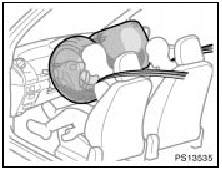
The SRS (Supplemental Restraint System) airbags are designed to provide further protection for the driver and front passenger in addition to the primary safety protection provided by the seat belts.
Your vehicle is equipped with “ADVANCED AIRBAGS” designed based on US motor vehicle safety standards (FMVSS208). The airbag system controls airbag deployment power for the driver and front passenger.
The driver airbag system consists of the driver seat’s position sensor etc. The front passenger’s airbag system consists of the front passenger occupant classification sensor etc.
In response to a severe frontal impact, the SRS airbags work with the seat belts to help reduce injury by inflating. The SRS airbags help reduce injuries mainly to the driver’s or front passenger’s head or chest caused by hitting the vehicle interior.
The SRS front passenger airbag will not activate if there is no passenger sitting in the front passenger seat. However, the front passenger airbag may deploy if luggage is put in the seat, or the seat belt is buckled up, regardless of the presence of an occupant in the seat. (As for the front passenger occupant classification system, see “Front passenger occupant classification system”).
Always wear your seat belt properly.
CAUTION.
The SRS front airbag system is designed only as a supplement to the primary protection of the driver and front passenger seat belt systems.
The driver and front passenger can be killed or seriously injured by the inflating airbags if they do not wear the available seat belts properly.
During sudden braking just before a collision, an unrestrained driver or front passenger can move forward into direct contact with or close proximity to the airbag which may then deploy during the collision.
To ensure maximum protection in an accident, the driver and all passengers in the vehicle must wear their seat belts properly. Wearing a seat belt properly during an accident reduces the chances of death or serious injury or being thrown out of the vehicle. For instructions and precautions concerning the seat belt system, see “Seat belts”.
Improperly seated and/or restrained infants and children can be killed or seriously injured by the deploying airbags. An infant or child who is too small to use a seat belt should be properly secured using a child restraint system. Toyota strongly recommends that all infants and children be placed in the rear seat of the vehicle and properly restrained. The rear seat is the safest for infants and children. For instructions concerning the installation of a child restraint system, see “Child restraint”.
The SRS airbags are designed to deploy in severe (usually frontal) collisions where the magnitude and duration of the forward deceleration of the vehicle exceeds the designed threshold level.
The SRS airbags will deploy if the severity of the impact is above the designed threshold level, comparable to an approximate 25 km/h (15 mph) collision when the vehicle has the impact straight into a fixed barrier that does not move or deform.
However, this threshold velocity will be considerably higher if the vehicle strikes an object, such as a parked vehicle or sign pole, which can move or deform on impact, or if the vehicle is involved in an underride collision (e.g. a collision in which the front of the vehicle “underrides”, or goes under, the bed of a truck, etc.).
It is possible that in some collisions where the forward deceleration of the vehicle is very close to the designed threshold level, the SRS airbags and the seat belt pretensioners may not activate together.
Always wear your seat belts properly.
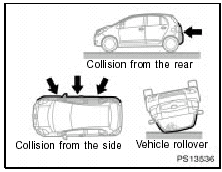
The SRS airbags are not generally designed to inflate if the vehicle is involved in a side or rear collision, if it rolls over, or if it is involved in a low- speed frontal collision. But, whenever a collision of any type causes sufficient forward deceleration of the vehicle, deployment of the SRS airbags may occur.
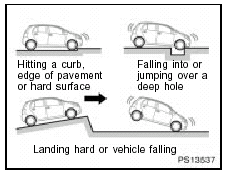
The SRS airbags may also deploy if a serious impact occurs to the underside of your vehicle. Some examples are shown in the illustration.
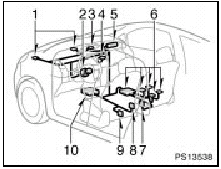
The SRS airbag system consists mainly of the following components, and their locations are shown in the illustration.
1. Front airbag sensors
2. Airbag module for driver (airbag and inflator)
3. SRS warning light
4. “AIRBAG ON” and “AIRBAG OFF” indicator lights
5. Airbag module for front passenger (airbag and inflator)
6. Front passenger occupant classification system (ECU and sensors)
7. Front passenger’s seat belt buckle switch
8. Driver’s seat belt buckle switch
9. Driver’s seat position sensor
10. Airbag sensor assembly
The airbag sensor assembly consists of a safing sensor and airbag sensor.
The front airbag sensors constantly monitor the forward deceleration of the vehicle.
If an impact results in a forward deceleration beyond the designed threshold level, the system triggers the airbag inflators. At this time a chemical reaction in the inflators very quickly fills the airbags with non- toxic gas to help restrain the forward motion of the occupants. The airbags then quickly deflate, so that there is no obstruction of the driver’s vision should it be necessary to continue driving.
When the airbags inflate, they produce a loud noise and release some smoke and residue along with non-toxic gas. This does not indicate a fire. This smoke may remain inside the vehicle for some time, and may cause some minor irritation to the eyes, skin or breathing. Be sure to wash off any residue as soon as possible to prevent any potential skin irritation with soap and water. If you can safely exit from the vehicle, you should do so immediately.
Deployment of the airbags happens in a fraction of a second, so the airbags must inflate with considerable force. While the system is designed to reduce serious injuries, primarily to the head and chest, it may also cause other, less severe injuries to the face, chest, arms and hands. These are usually in the nature of minor burns or abrasions and swelling, but the force of a deploying airbag can cause more serious injuries, especially if an occupant’s hands, arms, chest or head is in close proximity to the airbag module at the time of deployment. This is why it is important for the occupant to: avoid placing any object or part of the body between the occupant and the airbag module; sit straight and well back into the seat; wear the available seat belt properly; and sit as far as possible from the airbag module, while still maintaining control of the vehicle.
Parts of the airbag module (steering wheel hub, airbag cover and inflator) may be hot for several minutes after deployment, so do not touch! The airbags inflate only once. The windshield may be damaged by absorbing some of the force of the inflating airbag.
CAUTION.
The driver or front passenger who is too close to the steering wheel or dashboard during airbag deployment can be killed or seriously injured.
Toyota strongly recommends that: The driver sit as far back as possible from the steering wheel while still maintaining control of the vehicle.
The front passenger sit as far back as possible from the dashboard.
All vehicle occupants be properly restrained using the available seat belts.
For instructions and precautions concerning the seating position, see “—Front seat precautions”.
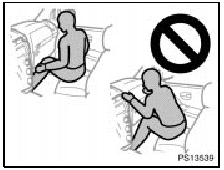
Do not sit on the edge of the seat or lean against the dashboard when the vehicle is in use, since the front passenger airbag could inflate with considerable speed and force.
Anyone who is up against, or very close to, an airbag when it inflates, can be killed or seriously injured.
Sit up straight and well back in the seat, and always use your seat belt properly.
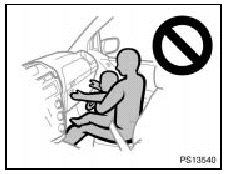
Toyota strongly recommends that all infants and children be placed in the rear seat of the vehicle and be properly restrained.
Do not hold a child on your lap or in your arms. Use a child restraint system in the rear seat. For instructions concerning the installation of a child restraint system, see “Child restraint”.
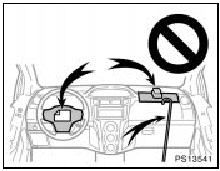
Do not put anything or any part of your body on or in front of the dashboard or steering wheel pad that houses the front airbag system.
They might restrict inflation or cause death or serious injury as they are projected rearward by the force of deploying airbags. Likewise, the driver and front passenger should not hold objects in their arms or on their knees.
Do not modify or remove any wiring.
Do not modify, remove, strike or open any components such as the steering wheel pad, steering wheel, column cover, dashboard near the front passenger airbag, front passenger airbag cover, front passenger airbag or airbag sensor assembly. Doing so may prevent the front airbag system from activating correctly, cause sudden activation of the system or disable the system, which could result in death or serious injury.
Failure to follow these instructions can result in death or serious injury.
Consult your Toyota dealer about any repair and modification.
If you wish to modify your vehicle for a person with physical disability, consult your Toyota dealer. If may dangerously interfere with the SRS front airbags operation.
NOTICE.
Do not perform any of the following changes without consulting your Toyota dealer. Such changes can interfere with proper operation of the SRS airbag system in some cases.
Installation of electronic devices such as a mobile two-way radio, cassette tape player or compact disc player Modification of the suspension system Modification of the front end structure Attachment of a grille guard (bull bar, kangaroo bar, etc.), snowplow, winches or any other equipment to the front end Repairs made on or near the front fenders, front end structure, console, steering column, steering wheel or dashboard near the front passenger airbag
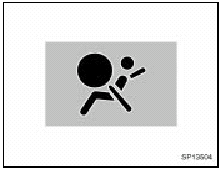
This indicator comes on when the ignition key is turned to the “ON” position.
It goes off after about 6 seconds. This means the SRS airbags are operating properly.
This warning light system monitors the airbag sensor assembly, front airbag sensors, side and curtain shield airbag sensors, curtain shield airbag sensors, driver’s seat position sensor, driver’s seat belt buckle switch, front passenger occupant classification system, “AIRBAG ON” indicator light, “AIRBAG OFF” indicator light, front passenger’s seat belt buckle switch, seat belt pretensioner assemblies, inflators, interconnecting wiring and power sources. (For details, see “Service reminder indicators and warning buzzers”).
If any of the following conditions occurs, this indicates a malfunction of the airbags or seat belt pretensioners. Contact your Toyota dealer as soon as possible.
The light does not come on when the ignition key is turned to the “ON” position or remains on for more than 6 seconds or flashes.
The light comes on or starts flashing while driving.
The SRS warning light and “AIRBAG OFF” indicator light will come on if there is a malfunction in the front passenger occupant classification system.
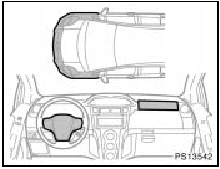
In the following cases, contact your Toyota dealer as soon as possible: The SRS airbags have been inflated.
The front part of the vehicle (shaded in the illustration) was involved in an accident that was not severe enough to cause the SRS airbags to inflate.
The pad part of the steering wheel or front passenger airbag cover (shaded in the illustration) is scratched, cracked, or otherwise damaged.
NOTICE.
Do not disconnect the battery cables before contacting your Toyota dealer.
 Seat belts
Seat belts
—Seat belt precautions
Toyota strongly urges that the driver and passengers in the vehicle be properly
restrained at all times with the seat belts provided. Failure to do so could increase
th ...
 SRS side airbags and curtain shield airbags
SRS side airbags and curtain shield airbags
The SRS (Supplemental Restraint System) side airbags and curtain shield airbags
are designed to provide further protection for the driver, front passenger and rear
outside passengers in addition ...
See also:
Checking battery condition
—Precautions
CAUTION.
BATTERY PRECAUTIONS.
The battery produces flammable and explosive hydrogen gas.
Do not cause a spark from the battery with tools.
Do not smoke or light a match near the ...
Rear door outer panel (CUT): Sedan Ex. U.S.A., Canada
REPLACEMENT
REMOVAL
INSTALLATION
Temporarily install the new parts and measure each part of the new parts in accordance
with the body dimension diagram. (See the body dimension diagram) Inspe ...
Floor side rail front panel (ASSY): Sedan
REPLACEMENT
With the body lower back panel removed.
REMOVAL
INSTALLATION
Temporarily install the new parts and measure each part of the new parts in accordance
with the body dimension diagra ...
